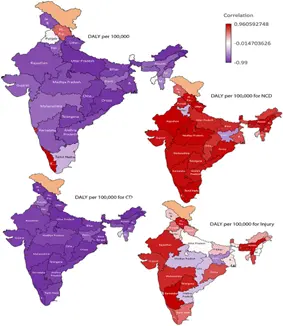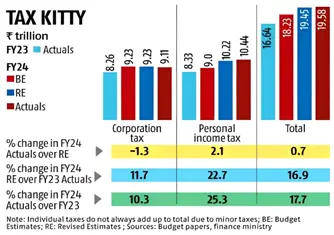Tuesday, 10th September 2024
India – UAE Bilateral Relationship
Why in the news?
- Recently, The Crown Prince of Abu Dhabi, Sheikh Khaled bin Mohamed bin Zayed Al Nahyan, is on a two-day first official visit to India.

India – UAE Bilateral Relationship:
- Political Relations:
- Diplomatic Establishment:
- Diplomatic relations between India and the UAE were established in 1972.
- The relationship has evolved significantly since its inception.
- Key Agreements and Visits:
- Comprehensive Strategic Partnership Agreement (2017): Strengthened bilateral ties with a broad framework for cooperation.
- High-Level Visits:
- February 2019: UAE invited India as "Guest of Honour" at the 46th Organisation of Islamic Cooperation (OIC) session.
- August 2019: PM Modi visited the UAE, receiving the 'Order of Zayed', the UAE’s highest civilian award.
- April 2019: Foundation stone for the first Hindu Temple in Abu Dhabi.
- February 2022: Virtual Summit between PM Modi and Crown Prince HH Sheikh Mohammed bin Zayed Al Nahyan, issuing a Joint Vision Statement.
- UAE was the guest country at the G-20 under India’s presidency.
- Diplomatic Establishment:
- Trade Relations:
- Trade Volume:
- India-UAE trade reached USD 85 billion in 2022-23, making the UAE India’s third-largest trading partner.
- UAE is the second-largest export destination for India, with exports valued at nearly USD 31.61 billion in 2022-23.
- Comprehensive Economic Partnership Agreement (CEPA):
- Signed in February 2022, it covers a wide range of tariff lines, enhancing trade relations between the two countries.
- Trade Volume:
- Investment:
- Investment Growth:
- Post-CEPA, UAE became the fourth-largest investor in India during 2022-23, up from seventh in 2021-22.
- UAE has committed USD 75 billion to India's infrastructure sector.
- Major Investments:
- Abu Dhabi Investment Authority invested USD 1 billion in the National Infrastructure Investment Fund (NIIF).
- Investment Growth:
- Trade Settlement in Local Currencies:
- MoU for Local Currency Settlement:
- Signed in July 2023, this MoU between RBI and the UAE Central Bank aims to facilitate trade settlement in INR and AED.
- Establishes a Local Currency Settlement System (LCSS) for cross-border transactions.
- MoU for Local Currency Settlement:
- Linking of Fast Payment Systems:
- Unified Payments Interface (UPI) and Instant Payment Platform (IPP): July 2023 agreement to link India’s UPI with UAE’s IPP to streamline cross-border payments.
- Educational Initiatives:
- IIT Delhi Campus in Abu Dhabi: 2023 MoU with Abu Dhabi's Education and Knowledge department to establish an IIT Delhi campus.
- NRI Remittances:
- High Remittances: UAE is a major source of remittances to India, accounting for 18% of total remittances (2020-21 data).
- Energy Cooperation:
- Strategic Partnerships:
- ADNOC and ISPRL (2017): MoU for establishing a strategic crude oil reserve in Mangalore.
- Crude Oil Storage: ADNOC exploring storage opportunities at ISPRL’s facilities.
- Production Concession Agreement: For Abu Dhabi Onshore Block 1, enabling Urja Bharat (a JV of IOCL and Bharat Petro resources Ltd) to bring crude oil to India.
- Strategic Partnerships:
- Indian Community:
- Expatriate Presence:
- Approximately 3.5 million Indians live in the UAE, constituting about 35% of the UAE’s population.
- A significant portion includes qualified professionals and businessmen.
- Expatriate Presence:
Key Highlights of Crown Prince of Abu Dhabi's Visit to India:
- MoUs and Agreements:
- Nuclear Cooperation: MoU between NPCIL and Emirates Nuclear Energy Corporation (ENEC) to enhance cooperation in nuclear energy.
- LNG Supply Agreement: Long-term agreement for LNG supply between ADNOC and Indian Oil Corporation Limited.
- Crude Storage MoU: Extension of ADNOC’s involvement in crude storage in India.
- Production Concession Agreement: For Abu Dhabi Onshore Block 1, first for an Indian company in the UAE.
- Food Parks Development: MoU between Gujarat Government and Abu Dhabi Developmental Holding Company PJSC (ADQ) to develop food parks in India
|
UPSC Civil Services Examination Previous Year Questions (PYQs) Prelims: Q:1 Which of the following is not a member of ‘Gulf Cooperation Council’? (2016)
Ans: (a)
Mains: Q:1 The question of India’s Energy Security constitutes the most important part of India’s economic progress. Analyse India’s energy policy cooperation with West Asian countries. (2017) Q:2 Religious indoctrination via digital media has resulted in Indian youth joining ISIS. What is ISIS and its mission? How can ISIS be dangerous to the internal security of our country? (2015) |
Source: NDTV
SBM Reduced Infant and Child Mortality
Why in the news?
- Science journal Nature recently has published a study titled ‘Toilet construction under the Swachh Bharat Mission (SBM) and infant mortality in India’.
- It analysed data from 35 states/Union territories and over 600 districts between 2011 and 2020.
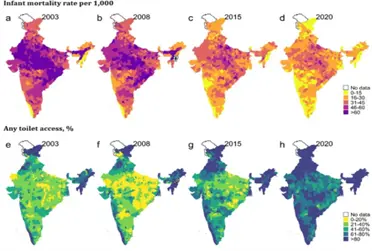
Key Findings:
- Reduction in Infant Deaths:
- SBM is estimated to have prevented 60,000-70,000 infant deaths annually from 2011 to 2020.
- Districts with over 30% of toilets constructed under SBM saw a reduction of 5.3 infant deaths and 6.8 child deaths per 1,000 births.
- A 10% increase in district-level toilet access after SBM correlated with a reduction in Infant Mortality Rate (IMR) by 0.9 points and Under-Five Mortality Rate (U5MR) by 1.1 points on average.
- Accelerated Decline in IMR:
- IMR reductions accelerated to 8-9% annually in the SBM period, compared to a 3% annual decline during the pre-SBM period (2000-2014).
- Toilet Availability:
- The availability of toilets doubled, and open defecation decreased from 60% to 19% within the first five years of SBM.
- Between 2014 and 2020, the government constructed 109 million household toilets and declared over 600,000 villages Open Defecation Free (ODF).
- Additional Benefits:
- Improved sanitation has led to enhanced women's safety, reduced health costs (average savings of Rs 50,000 annually), and a better overall quality of life.
- SBM’s Approach:
- SBM’s comprehensive strategy includes constructing toilets, substantial investments in Information, Education, and Communication (IEC), and active community engagement.
About Swachh Bharat Mission (SBM):
- Launch: Announced by Prime Minister on Independence Day 2014 and officially launched on 2nd October 2014.
- Scope:
- Recognized as India’s largest cleanliness drive, involving 3 million government employees, students, and community members.
- Phase-II (February 2020): Focuses on sustaining the Open Defecation Free (ODF) status and Solid and Liquid Waste Management (SLWM).
Key Principles and Goals:
- Toilet Construction:
- Build individual, cluster, and community toilets to reduce or eliminate open defecation.
- Monitoring:
- Establish mechanisms to monitor both the construction and usage of toilets.
- Public Awareness:
- Promote awareness about the drawbacks of open defecation and encourage the use of toilets.
- Behavioural Change:
- Aim to change attitudes and behaviours towards sanitation through dedicated ground staff and campaigns.
- Clean Villages:
- Ensure cleanliness and effective solid and liquid waste management through gram panchayats.
- Water Supply:
- Install water pipelines to provide access to water in all households.
- Funding:
- SBM had an average annual budget of approximately USD 1.25 billion from 2015 to 2020, demonstrating the government's significant investment in sanitation and public health.
- Financial and technical support, including contributions through Swachh Bharat Kosh and involvement of Swachh Bharat Preraks for monitoring.
Significance of SBM:
- Public Health Impact:
- Improved sanitation under SBM has been linked to significant reductions in IMR and U5MR, reflecting global trends that improved sanitation contributes to better health outcomes.
- Addressing 'Asian Enigma':
- The study supports research on the ‘Asian Enigma,’ where India’s high child stunting rates, despite economic growth, were attributed to widespread open defecation.
- SBM’s success in reducing open defecation aims to address this issue.
- Economic Benefits:
- UNICEF reports that every rupee invested in SBM yields a return of Rs 4.3 due to reduced healthcare costs and increased productivity.
- Achieving SBM’s goals could lower the damage costs to 2.7% of GDP, saving Rs 8.1 trillion.
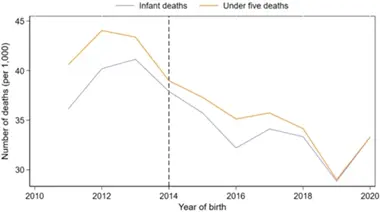
Challenges in SBM Implementation:
- Behavioural Resistance:
- Open defecation is sometimes considered healthier, cleaner, or culturally acceptable in some rural areas.
- Non-Functional Toilets:
- Toilets often remain non-functional due to inadequate or absent water facilities. Pit-based toilets face issues with pit filling and faecal material management.
- Hand Hygiene:
- Inconsistent hand hygiene practices due to lack of facilities such as water, soap, and handwashing spaces.
- Marginalised Communities:
- Disadvantaged groups, including landless people, migrant workers, and those with disabilities, often lack access to or face difficulties using toilets.
Way Forward:
- Maintain ODF Status:
- Continuous monitoring is required to sustain the ODF status, with trained volunteers and incentives needed to oversee sanitation practices.
- Promote Behavioural Change:
- Engage communities through education and participatory self-analysis to foster long-term behavioural change.
- Address Manual Scavenging:
- Implement technology solutions, such as the Robot Bandicoot, to end manual scavenging practices.
- Collaborations:
- Enhance coordination among various stakeholders, including government departments, NGOs, and international organisations, to optimise efforts and avoid duplication.
|
UPSC Civil Services Examination, Previous Year Question (PYQ) Prelims Q:1 With reference to bio-toilets used by the Indian Railways, consider the following statements: (2015)
Which of the statements given above is/are correct?
Ans: (d)
Mains Q:1 What are the impediments in disposing of the huge quantities of discarded solid waste which are continuously being generated? How do we safely remove the toxic wastes that have been accumulating in our habitable environment? (2021) Q:2 “To ensure effective implementation of policies addressing the water, sanitation and hygiene needs the identification of the beneficiary segments is to be synchronised with anticipated outcomes.” Examine the statement in the context of the WASH scheme. (2017) Q:3 How could social influence and persuasion contribute to the success of Swachh Bharat Abhiyan? (2016) |
Source: DTE
Copper Production in India
Why in the news?
- India's copper production decreased to 3.78 million tonnes (Mt) in FY24 from 4.13 Mt in FY19, according to Ministry of Mines data.
- This reduction has led to a significant increase in copper concentrate imports, which surged to ₹26,000 crore in FY24 from FY19.
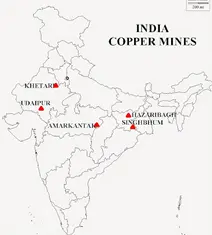
Copper Metal and Its Reserves in India:
- About the Metal:
- Copper is a soft, malleable, and ductile metal known for its high thermal and electrical conductivity.
- It is one of the few metals found naturally in a usable metallic form.
- Copper is used in various industries, including defence, space programs, railways, power cables, and telecommunications.
- Reserves in India:
- India holds approximately 2% of the world’s copper reserves.
- The largest reserves, totaling 813 million tonnes (53.81% of the country's total copper resources), are in Rajasthan.
- Significant reserves are also found in Jharkhand and Madhya Pradesh.
- The Khetri Mine in Rajasthan is one of the largest copper mines in India.
- Additional copper reserves are located in Andhra Pradesh, Gujarat, Haryana, Karnataka, Maharashtra, Meghalaya, Nagaland, and Odisha.
Copper Ore Production in India
- Production and Self-Sufficiency:
- India’s copper production constitutes around 2% of global production.
- The country is not self-sufficient in copper ore production, relying on a mix of domestic production, recycling, and imports to meet demand.
- India imports copper concentrates for smelting and refining, which are essential for producing various copper products.
- Key Players:
- Hindustan Copper Limited (HCL) is the only public sector company involved in the full copper value chain, including mining, beneficiation, smelting, and refining.
- Major private sector companies like Hindalco Industries Ltd and Vedanta Limited depend on imported copper concentrates and have mining interests abroad.
Current Status of Copper Ore Production in India:
- Exploration Challenges:
- India’s copper ore reserves are estimated at 208 million tonnes, mostly of low grade.
- The total copper resource is approximately 1.51 billion tonnes, requiring extensive exploration to convert these resources into viable reserves.
- The National Mineral Exploration Trust (NMET) overseas exploration but has faced challenges due to insufficient exploration and limited private sector participation.
- In FY24 and FY23, NMET approved only two copper exploration projects.
- Recent Developments:
- The Ministry of Mines has updated rules to encourage private sector involvement in exploring critical minerals like copper.
- India’s increasing reliance on copper imports, driven by its role in clean energy technologies, has led to efforts to secure copper supply chains.
- Private players are partnering with the Ministry to explore new import sources and invest in copper mines in countries such as Mongolia, Zambia, and Chile.

|
UPSC Civil Services Examination Previous Year Question (PYQ) Prelims Q:1 With reference to the mineral resources of India, consider the following pairs: (2010) Mineral: 90% Natural sources in
Which of the pairs given above is/are correctly matched?
Ans: (b)
Mains Q1. Despite India being one of the countries of Gondwanaland, its mining industry contributes much less to its Gross Domestic Product (GDP) in percentage. Discuss. (2021) |
Source: IE
Challenges to Road Safety in India
Why in the news?
- The "India Status Report on Road Safety 2024," prepared by the TRIP Centre at IIT Delhi, sheds light on the slow progress made in reducing road accident deaths and emphasises the need for focused interventions.
- Some states, such as Tamil Nadu, Telangana, and Chhattisgarh, report high death rates of over 17 per 100,000 people.
- On the other hand, states like West Bengal and Bihar have much lower rates, around 5.9 per 100,000 people.
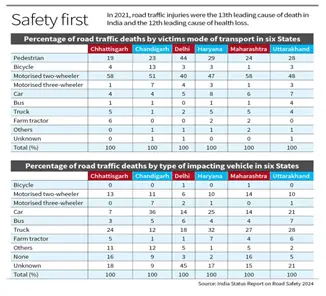
Significance of Road Safety in India
- About:
- Dominance of Road Transport: Road transport is the primary mode of transport in India, contributing significantly to traffic share and the national economy.
- Expansion and Growth: The increase in the number of vehicles and the length of the road network has been driven by rising demand for road transport.
- Negative Externalities: The expansion in road infrastructure, motorization, and urbanisation has led to a rise in road accidents and fatalities.
- Causes:
- Infrastructural Deficits:
- Poor road conditions and vehicle maintenance.
- Inadequate visibility and substandard road design, including issues with single-lane roads and sharp curves.
- Negligence and Risks:
- Over speeding and driving under the influence of alcohol or drugs.
- Fatigue and riding without helmets or driving without seatbelts.
- Distraction:
- Increased accidents due to talking on mobile phones while driving.
- Overloading:
- Cost-saving measures leading to overloading of vehicles.
- Weak Vehicle Safety Standards:
- 2014 crash tests revealed failures in some top-selling car models in India.
- Lack of Awareness:
- Insufficient awareness about safety features like airbags and anti-lock braking systems.
- Infrastructural Deficits:
- Impacts:
- Economic:
- Road accidents cause a loss of 3% of India’s GDP, most of which is preventable.
- Social:
- Burden on Households:
- Road accident deaths deplete nearly seven months of household income in poor families, leading to cycles of poverty and debt.
- Vulnerable Road Users (VRUs):
- VRUs, including poor male road users of working age, face a disproportionate burden, representing over half of road crash deaths and serious injuries.
- Gender-Specific Impact:
- Women in victims' families experience increased burdens, taking up extra work and assuming greater responsibilities.
- According to the World Bank report “Traffic Crash Injuries and Disabilities: The Burden on Indian Society, 2021,” around 50% of women were severely affected by income decline, 40% reported changes in their working patterns, and 11% took up additional work. Rural low-income households faced the most severe income declines (56%).
- Burden on Households:
- Economic:
How Can Road Accidents be Controlled?
- Transparent Machinery:
- E-Challan Implementation: Reduces corruption by streamlining traffic infringement fines.
- Speed-Detection Devices:
- Radar and Cameras: Installation of radar guns and speed cameras in cities like Chandigarh and New Delhi to monitor speed.
- Improved Safety Measures:
- Infrastructure Enhancements: Implementation of speed humps, raised platforms, roundabouts, and optical markings.
- Stricter Rules and Heavy Fines:
- Enhanced Penalties: Imposition of heavy fines for traffic violations, particularly for driving under the influence.
- Vehicular Safety Standards:
- Mandatory Features: Enforcement of vehicle safety features such as electronic stability control and advanced braking systems.
- Bharat NCAP: Introduction of the New Car Assessment Programme by the Ministry of Road Transport and Highways.
- Role of Bystanders:
- Emergency Care: Encouraging bystanders to take immediate actions and activate emergency care systems.
- Training and Capacity Building:
- Workshops: Organising training courses in road safety audits and engineering.
Initiatives Related to Road Safety:
- Global:
- Brasilia Declaration on Road Safety (2015): Signed by India, aiming to halve global road traffic deaths and injuries by 2030.
- Decade of Action for Road Safety 2021-2030: UN resolution to prevent at least 50% of road traffic deaths and injuries by 2030.
- International Road Assessment Programme (iRAP): Charity focused on safer roads.
- India:
- Motor Vehicles Amendment Act, 2019:
- Penalties: Increased fines for traffic violations.
- Insurance Fund: Provides compulsory insurance cover for road users.
- National Road Safety Board: Establishment of a board for road safety.
- Carriage by Road Act, 2007:
- Regulation: Limits liability for common carriers and determines value declarations for goods.
- Control of National Highways (Land and Traffic) Act, 2000:
- Land Control: Regulates land and traffic on National Highways.
- National Highways Authority of India Act, 1998:
- Authority Formation: Establishes an authority for the development and management of National Highways.
- Motor Vehicles Amendment Act, 2019:
Source: TH
The role of district Agro- Meteorology offices in supporting
Why in the news?
- The India Meteorological Department (IMD) plans to revive District Agro-Meteorology Units (DAMUs) under the Gramin Krishi Mausam Sewa (GKMS) scheme.
- DAMUs were first established in 2018, in collaboration with the Indian Council of Agricultural Research (ICAR), to provide localised agricultural advisories based on weather data.
- The revival aims to reinstate these units to aid agricultural activities with weather-based insights.

Gramin Krishi Mausam Sewa (GKMS) Scheme
- About: GKMS is an IMD initiative designed to offer weather-based advisories to enhance farmers' decision-making, mitigate weather-related risks, and boost crop productivity.
- Features:
- Weather Forecasts: Provides medium-range forecasts (5-7 days) including rainfall, temperature, humidity, wind speed, and direction.
- Agro-Meteorological Advisory Services (AAS): Offers weather-based bulletins in local languages to help farmers manage crops and livestock.
- Dissemination: Advisories are shared via SMS, mobile apps, radio, television, and local government bodies.
District Agro-Meteorology Units (DAMUs)
- About: DAMUs were established through collaboration between IMD and ICAR to provide localised weather information and advisories.
- Function: Provide block-level agro-meteorological advisories to assist farmers with daily agricultural operations, minimise crop losses, and optimise land and resource use.
- Importance:
- Support for Small Farmers: With 80% of Indian farmers being small and marginal, often relying on rain-fed agriculture, DAMUs offer critical weather information to adapt to climate changes.
- Advisory Services: DAMUs issue advisories on activities like sowing, irrigation, and extreme weather warnings, reaching millions of farmers in local languages twice a week. Dissemination methods include text messages, WhatsApp, newspapers, and direct communication.
- Impact: Reports, such as those from the National Institute of Advanced Studies (NIAS), demonstrate that localised advisories improve farmers' response to climate variations, resulting in better yields and incomes.
Reasons for DAMU Shutdown
- Misrepresentation: NITI Aayog inaccurately represented DAMUs' role and recommended privatisation, claiming that agro-meteorological data was automated and undermining the critical function of DAMU staff.
- Monetization Proposal: There was a proposal to monetize agro-meteorological services, which are currently provided free to farmers, contrary to their intended purpose.
Source: TH
In Bengaluru Kawasaki Disease
Why in the news?
- A recent observation by a doctor in Bengaluru noted an increase in Kawasaki disease cases among children following the severe second wave of COVID-19.

About Kawasaki Disease:
- Alternate Names: Kawasaki disease is also referred to as Kawasaki syndrome or mucocutaneous lymph node syndrome.
- Overview: This rare condition primarily affects children under the age of 5 and results in fever and inflammation of the blood vessels.
- Prevalence: Kawasaki disease is among the most common types of acquired heart disease in children.
- Pathology: The disease prompts the immune system to target and inflame blood vessels, particularly impacting the coronary arteries that supply blood to the heart muscle. It can also cause issues with lymph nodes, skin, and the mucous membranes of the mouth, nose, and throat.
- Symptoms: Key clinical signs include high fever, rash, swelling of the hands and feet, redness and irritation of the whites of the eyes, swollen lymph nodes in the neck, and inflammation of the mouth, lips, and throat.
- Historical Context: The disease was first identified by Tomisaku Kawasaki in Japan in 1967, with the first reported cases outside Japan occurring in Hawaii in 1976.
- Cause: The exact cause of Kawasaki disease remains unknown, although it tends to occur more frequently in late winter and early spring.
Source: FE
Yudh Abhyas
Why in the news?
- Recently, India-U.S. bilateral Army exercise Yudh Abhyas is set to commence at the Mahajan field firing ranges in Rajasthan.

About Yudh Abhyas
- About:
- Nature: Yudh Abhyas is a joint military exercise held annually between India and the USA.
- Inception: The exercise has been conducted since 2004.
- Purpose: Its primary objectives are to enhance cooperation between the two militaries through training, cultural exchanges, and the development of joint operational skills.
- Recent Edition: The previous edition took place at Fort Wainwright, Alaska, USA.
- Yudh Abhyas 2024:
- Significance: This year marks the 20th edition of the exercise.
- Location: The 2024 edition is scheduled to be held at the Mahajan Field Firing Range in Rajasthan, India.
- Objective: It aims to improve interoperability and strengthen the operational capabilities of both the Indian and U.S. forces.
- Features: The exercise will include a variety of advanced military tactics and coordinated manoeuvres designed to boost the readiness of both armies for high-stakes situations.
- U.S. Contingent: This edition will feature one of the largest U.S. contingents ever, with around 600 personnel. Additionally, the U.S. Army will deploy Stryker infantry vehicles and the M142 HIMARS (High Mobility Artillery Rocket System).
- Advanced Equipment: The M142 HIMARS, known for its precision strike capabilities and use in Ukraine, will be part of the exercise, enhancing its strategic depth.
Source: TH
Sugamya Bharat App
Why in the news?
- Since its launch in 2021, the Sugamya Bharat mobile application has received over 1,400 complaints related to accessibility and 75 percent of these complaints have been successfully resolved.
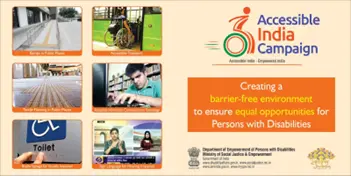
About the Sugamya Bharat App:
- About:
- Initiative: Launched by the Department of Empowerment of Persons with Disabilities (DEPwD), Ministry of Social Justice and Empowerment.
- Purpose: Designed to assist individuals with disabilities and the elderly by allowing them to report accessibility issues in public infrastructure, transportation, and buildings.
- Objectives:
- Identification of Issues: Captures and reports complaints related to accessibility at public places. The app uses Google Maps to pinpoint the exact location of the problem.
- Uploading Geotagged Pictures: Users can upload photos to provide visual evidence of accessibility issues, helping to identify specific problems in various types of public spaces.
- Complaint Registration: Individuals facing accessibility issues in India can register their concerns on the app. The focus is on issues related to buildings, transportation systems, and ICT (websites and TV viewing).
- Forwarding Complaints: Complaints, accompanied by photos, are sent to relevant authorities for resolution.
- Future Enhancements:
- AI Integration: The government plans to redesign the app to incorporate AI capabilities, including an AI-powered chatbot and a multilingual interface, to enhance functionality.
- Partnerships: Collaborating with NGO Mission Accessibility and the research institute I-STEM to develop the AI-enabled version of the app.
Source: BS
Sukanya yojana
Why in the news?
- Recently, the government of India made changes to the rules of the Sukanya Samriddhi Yojana, which are planned to come into force from the 1st of October 2024.

About the Sukanya Samriddhi Yojana (SSY):
- About:
- Launch: Initiated in 2015 under the Government of India's "Beti Bachao Beti Padhao" campaign.
- Purpose: Aims to promote the education of girl children by providing a small-deposit savings scheme specifically for them.
- Eligibility:
- Residency: The girl must be an Indian resident.
- Account Holder: The account can be opened by the parent or legal guardian of the girl child.
- Age Limit: The girl must be under 10 years old at the time of opening the account.
- Account Limit: Only one SSY account per girl child and a maximum of two accounts per family.
- NRIs: Not eligible to open SSY accounts.
- Operation Age: The girl must operate the account once she turns 18 years old.
- Features:
- Deposit Limits: Minimum deposit of ₹250 and a maximum of ₹1.5 lakh per year, in multiples of ₹100.
- Deposit Duration: Deposits are made for 15 years, with maturity occurring after 21 years.
- Interest: No interest payable after 21 years from the account opening date.
- Partial Withdrawal:
- Eligibility: Up to 50% of the amount can be withdrawn for educational purposes after the girl turns 18 or has passed 10th standard, whichever comes first.
- Tax Benefits:
- Section 80C Deductions: Investments in SSY are deductible up to ₹1.5 lakh under Section 80C of the Income Tax Act.
- Tax-Exempt Interest: Interest earned on the SSY account is exempt from tax under Section 10.
- Tax-Free Proceeds: Proceeds upon maturity or withdrawal are also tax-exempt.
- New Rules:
- Guardian Changes: Accounts under non-legal guardian grandparents must be transferred to natural guardians or legal guardians. Failure to do so will result in permanent closure of the account.
- Irregular Accounts: Accounts exceeding the two-account limit per family will be closed as they violate scheme rules
Source: LM
Good Digital Public Infrastructure
Why in the news?
- India’s extraordinary achievement of over 80% financial inclusion within just six years stands as a testament to its innovative approach to digital and financial inclusion.
- This achievement has not only earned global admiration but also positioned India as a guiding light for the Global South.

What is Digital Public Infrastructure?
- Definition:
- Digital Public Infrastructure (DPI) encompasses the essential digital systems and services provided by the government or public sector to bolster and advance the digital economy and society. It includes:
- Digital Identity Systems: Platforms for verifying and managing individuals' identities online, such as Aadhaar in India.
- Digital Payment Systems: Infrastructure supporting secure financial transactions, including digital wallets, payment gateways, and banking platforms.
- Public Digital Services: Government-provided online services, such as e-governance portals, public health information, and digital education platforms.
- Data Infrastructure: Systems for secure data storage, management, and sharing, ensuring data sovereignty and privacy.
- Cybersecurity Frameworks: Measures and protocols to protect digital assets and personal information from cyber threats.
- Broadband and Connectivity: Infrastructure ensuring widespread and equitable access to high-speed internet across regions.
- Digital Public Infrastructure (DPI) encompasses the essential digital systems and services provided by the government or public sector to bolster and advance the digital economy and society. It includes:
Key Developments in India's Digital Public Infrastructure
- Unified Payments Interface (UPI): UPI has transformed digital payments in India with remarkable growth since its inception.
- UPI transactions increased from 92 crore in FY 2017-18 to 8,375 crore in FY 2022-23.
- The system has expanded internationally, with countries like UAE, Singapore, and France adopting or considering UPI.
- Recent innovations include UPI integration with credit cards and the launch of UPI Lite for offline transactions.
- These advancements have not only boosted financial inclusion but also established India as a global leader in digital payments.
- Aadhaar Ecosystem: Aadhaar, India's biometric identification system, serves as the foundation for numerous government and private sector services.
- With over 1.3 billion enrollments, it is the world’s largest biometric ID system.
- Integration with Digi Locker has facilitated secure document storage and sharing.
- The Aadhaar ecosystem has effectively reduced fraud in welfare distribution and streamlined Know Your Customer (KYC) processes.
- Open Network for Digital Commerce (ONDC): ONDC is India’s ambitious initiative to democratise e-commerce.
- Launched in the pilot phase across multiple cities, it aims to bring 30 million sellers and 10 million merchants online.
- By creating an open network, ONDC challenges existing e-commerce monopolies and offers a level playing field for small and medium enterprises.
- Account Aggregator Framework: The Account Aggregator framework is revolutionising financial data sharing in India.
- It allows secure, consent-based sharing of financial information across institutions.
- As of 2023, over 1.1 billion accounts are Account Aggregator-enabled across various banks.
- This system benefits Micro, Small, and Medium Enterprises (MSMEs) by providing faster loan processing and improved credit access.
- Digital Health Initiatives: India’s digital health ecosystem, driven by the Ayushman Bharat Digital Mission, is advancing significantly.
- As of December 2023, 50 crore individuals have an Ayushman Bharat Health Account (ABHA) as their unique health ID.
- The CoWIN platform, initially used for Covid-19 vaccination, is now repurposed for universal immunisation programs.
- Telemedicine consultations have surged, with platforms like eSanjeevani conducting over 100 million consultations.
- These initiatives are enhancing healthcare access and efficiency across India.
- Digital India BHASHINI: BHASHINI (BHASHa Interface for India) is an AI-powered language translation platform aimed at overcoming language barriers in digital communication.
- It is being integrated into various government websites and apps to improve accessibility.
- Central Bank Digital Currency (CBDC): The Reserve Bank of India launched the Digital Rupee pilot in December 2022, marking India's entry into the CBDC space.
- By mid-2023, over 2.2 crore transactions had been processed under the CBDC pilot.
- This initiative aims to reduce currency management costs and facilitate real-time, cost-effective cross-border transactions.
- Government e-Marketplace (GeM): The GeM portal has experienced significant growth in procurement, exceeding Rs 1.24 lakh crore in the first quarter of 2024-25.
- This system has achieved a 10% reduction in public procurement costs.
- GeM’s success has led to its adoption by public sector enterprises and its model is being evaluated by other countries for potential replication.
Note: India Stack, comprising open APIs and digital public goods like Aadhaar, UPI, and Digi Locker, continues to evolve as the backbone of India’s digital infrastructure. The Consent Layer, part of the Data Empowerment and Protection Architecture (DEPA), facilitates secure data sharing.
Major Challenges Related to India’s Digital Public Infrastructure
- The Digital Divide Dilemma: The digital divide remains a significant issue, marked by disparities in technology access and digital literacy.
- As of 2022, India's internet penetration was approximately 52% (Internet in India Report 2022), leaving around half the population offline.
- Rural areas lag behind urban centres in digital adoption, with many village residents still relying on cash despite booming UPI transactions in cities.
- The National Family Health Survey 2019-21 found that only 33% of Indian women used the internet, compared to 57% of men.
- Digital Literacy Lag: While infrastructure development is crucial, improving digital literacy is equally important.
- Despite initiatives like the Pradhan Mantri Gramin Digital Saksharta Abhiyan, a significant portion of the population remains digitally illiterate.
- This impacts the adoption and effective use of digital services, from UPI to e-governance platforms.
- Vulnerability to External Shocks: Recent global IT system outages, triggered by a faulty software update from CrowdStrike, caused widespread disruptions across various Windows operating systems.
- This overdependence exposed a lack of robust fail-safe mechanisms, highlighting the need for a more resilient digital ecosystem.
- Increased digitization also heightens cybersecurity risks, with India facing over 3,000 cyberattacks per week. For example, the 2023 ransomware attack on AIIMS Delhi revealed vulnerabilities in critical infrastructure.
- Vernacular Issues: In a country with 22 official languages and numerous dialects, language barriers pose a significant challenge to digital adoption.
- While initiatives like BHASHINI aim to address this, comprehensive language support across all digital platforms remains a challenge.
- Many government apps and websites are still predominantly in English or Hindi, limiting their reach.
- Digital Sovereignty Struggle: India’s push for data localization, reflected in draft policies, seeks to ensure digital sovereignty.
- However, this creates challenges for global tech companies and affects cross-border data flows.
- For instance, the Reserve Bank of India's mandate for local storage of payment data has led to compliance challenges for international payment providers.
- The Digital Personal Data Protection Act, 2023 allows personal data transfer outside India, but only to countries notified by the central government. This mechanism may not adequately assess data protection standards in those countries.
- Personal Data Privacy Paradox: As digital services expand, concerns about data privacy and security grow.
- The Digital Personal Data Protection Act, 2023, has not yet been fully implemented.
- Past incidents, such as the Aadhaar data breaches reported in 2018, have raised public concerns about data privacy.
Steps to Enhance the Resilience of India’s Digital Public Infrastructure
- Enhanced Cybersecurity Measures:
- Increase the cybersecurity budget to reflect its growing importance.
- Conduct mandatory cybersecurity audits for critical infrastructure to identify and address vulnerabilities.
- Implement a national cyber incident response plan with regular drills to improve readiness for large-scale attacks.
- Interoperability Standards:
- Develop and enforce national standards for digital service integration and data exchange.
- Create an Open API policy for government services to foster innovation and third-party development.
- Establish a regulatory sandbox for testing financial service interoperability to balance innovation with security.
- Adopt the IndEA (India Enterprise Architecture) framework to standardise digital transformation across sectors.
- Inclusive Digital Literacy Programs:
- Launch "Digital Saksharta Abhiyan 2.0" to teach practical digital skills, partnering with NGOs and tech companies to reach remote areas.
- Introduce digital literacy modules in secondary school curricula to build a strong foundation.
- Develop targeted programs for women, the elderly, and marginalised communities to bridge the digital divide.
- Cyber Security Board:
- Establish a Cyber Security Board with government and private sector representatives to analyse major cyber incidents and recommend improvements.
- Implement zero-trust architecture, enforce a standardised incident response playbook, and modernise state networks and response policies.
- Agile Regulatory Framework:
- Create a multi-stakeholder Digital Economy Task Force for adaptive policymaking that evolves with technological advancements.
- Develop technology-neutral, principle-based regulations to maintain oversight while allowing flexibility.
- Infrastructure Expansion:
- Accelerate the Bharat Net project to provide high-speed internet to all 600,000 villages.
- Promote edge computing to enhance service delivery in remote areas, reducing latency and improving user experience.
- Develop a national strategy for efficient 5G rollout and beyond to lead in wireless technology.
- Vernacular Digital Content:
- Mandate multi-lingual support for all government digital services to ensure inclusivity.
- Develop AI-powered real-time translation tools to break down language barriers on digital platforms.
- Implement voice-based interfaces to make technology accessible to those with literacy challenges.
- Green Digital Infrastructure:
- Set energy efficiency standards for data centres and digital infrastructure to promote sustainability.
- Encourage the use of renewable energy to reduce the carbon footprint of the digital economy.
- Incentivize the adoption of green technology in the IT sector to align digital growth with environmental sustainability goals.
|
UPSC Civil Services Examination, Previous Year Question Prelims Q:1 Consider the following statements about G-20: (2023)
Which of the statements given above is/are correct?
Answer: C
Q:2 Consider the following statements: (2018)
Which of the statements given above is/are correct?
Ans: (d)
Q:3 In India, under cyber insurance for individuals, which of the following benefits are generally covered, in addition to payment for the loss of funds and other benefits? (2020)
Select the correct answer using the code given below:
Ans: (b)
Q:4 In India, it is legally mandatory for which of the following to report on cyber security incidents? (2017)
Select the correct answer using the code given below:
Ans: (d)
Mains Q:1 What are the different elements of cyber security? Keeping in view the challenges in cyber security, examine the extent to which India has successfully developed a comprehensive National Cyber Security Strategy. (2022) |
Source: IE
Share the article
Edukemy’s Current Affairs Quiz is published with multiple choice questions for UPSC exams
MCQ
Get Latest Updates on Offers, Event dates, and free Mentorship sessions.

Get in touch with our Expert Academic Counsellors 👋
FAQs
UPSC Daily Current Affairs focuses on learning current events on a daily basis. An aspirant needs to study regular and updated information about current events, news, and relevant topics that are important for UPSC aspirants. It covers national and international affairs, government policies, socio-economic issues, science and technology advancements, and more.
UPSC Daily Current Affairs provides aspirants with a concise and comprehensive overview of the latest happenings and developments across various fields. It helps aspirants stay updated with current affairs and provides them with valuable insights and analysis, which are essential for answering questions in the UPSC examinations. It enhances their knowledge, analytical skills, and ability to connect current affairs with the UPSC syllabus.
UPSC Daily Current Affairs covers a wide range of topics, including politics, economics, science and technology, environment, social issues, governance, international relations, and more. It offers news summaries, in-depth analyses, editorials, opinion pieces, and relevant study materials. It also provides practice questions and quizzes to help aspirants test their understanding of current affairs.
Edukemy's UPSC Daily Current Affairs can be accessed through:
- UPSC Daily Current Affairs can be accessed through Current Affairs tab at the top of the Main Page of Edukemy.
- Edukemy Mobile app: The Daily Current Affairs can also be access through Edukemy Mobile App.
- Social media: Follow Edukemy’s official social media accounts or pages that provide UPSC Daily Current Affairs updates, including Facebook, Twitter, or Telegram channels.



